Zied Bouraoui
Towards a Neurosymbolic Reasoning System Grounded in Schematic Representations
Sep 03, 2025Abstract:Despite significant progress in natural language understanding, Large Language Models (LLMs) remain error-prone when performing logical reasoning, often lacking the robust mental representations that enable human-like comprehension. We introduce a prototype neurosymbolic system, Embodied-LM, that grounds understanding and logical reasoning in schematic representations based on image schemas-recurring patterns derived from sensorimotor experience that structure human cognition. Our system operationalizes the spatial foundations of these cognitive structures using declarative spatial reasoning within Answer Set Programming. Through evaluation on logical deduction problems, we demonstrate that LLMs can be guided to interpret scenarios through embodied cognitive structures, that these structures can be formalized as executable programs, and that the resulting representations support effective logical reasoning with enhanced interpretability. While our current implementation focuses on spatial primitives, it establishes the computational foundation for incorporating more complex and dynamic representations.
Enhancing DR Classification with Swin Transformer and Shifted Window Attention
Apr 20, 2025Abstract:Diabetic retinopathy (DR) is a leading cause of blindness worldwide, underscoring the importance of early detection for effective treatment. However, automated DR classification remains challenging due to variations in image quality, class imbalance, and pixel-level similarities that hinder model training. To address these issues, we propose a robust preprocessing pipeline incorporating image cropping, Contrast-Limited Adaptive Histogram Equalization (CLAHE), and targeted data augmentation to improve model generalization and resilience. Our approach leverages the Swin Transformer, which utilizes hierarchical token processing and shifted window attention to efficiently capture fine-grained features while maintaining linear computational complexity. We validate our method on the Aptos and IDRiD datasets for multi-class DR classification, achieving accuracy rates of 89.65% and 97.40%, respectively. These results demonstrate the effectiveness of our model, particularly in detecting early-stage DR, highlighting its potential for improving automated retinal screening in clinical settings.
Grounding Agent Reasoning in Image Schemas: A Neurosymbolic Approach to Embodied Cognition
Mar 31, 2025Abstract:Despite advances in embodied AI, agent reasoning systems still struggle to capture the fundamental conceptual structures that humans naturally use to understand and interact with their environment. To address this, we propose a novel framework that bridges embodied cognition theory and agent systems by leveraging a formal characterization of image schemas, which are defined as recurring patterns of sensorimotor experience that structure human cognition. By customizing LLMs to translate natural language descriptions into formal representations based on these sensorimotor patterns, we will be able to create a neurosymbolic system that grounds the agent's understanding in fundamental conceptual structures. We argue that such an approach enhances both efficiency and interpretability while enabling more intuitive human-agent interactions through shared embodied understanding.
Modelling Multi-modal Cross-interaction for ML-FSIC Based on Local Feature Selection
Dec 18, 2024
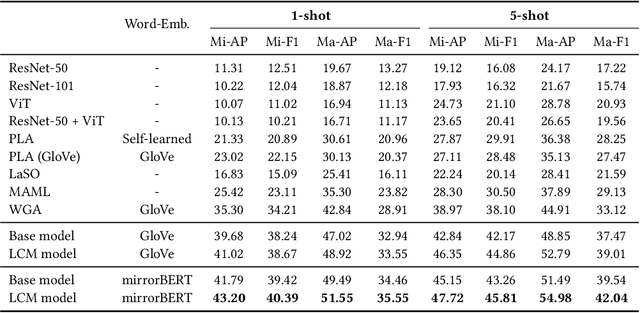

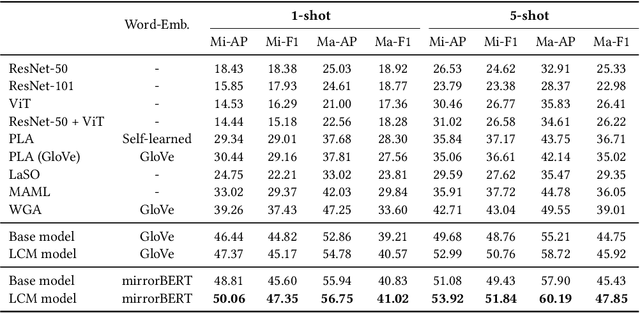
Abstract:The aim of multi-label few-shot image classification (ML-FSIC) is to assign semantic labels to images, in settings where only a small number of training examples are available for each label. A key feature of the multi-label setting is that images often have several labels, which typically refer to objects appearing in different regions of the image. When estimating label prototypes, in a metric-based setting, it is thus important to determine which regions are relevant for which labels, but the limited amount of training data and the noisy nature of local features make this highly challenging. As a solution, we propose a strategy in which label prototypes are gradually refined. First, we initialize the prototypes using word embeddings, which allows us to leverage prior knowledge about the meaning of the labels. Second, taking advantage of these initial prototypes, we then use a Loss Change Measurement~(LCM) strategy to select the local features from the training images (i.e.\ the support set) that are most likely to be representative of a given label. Third, we construct the final prototype of the label by aggregating these representative local features using a multi-modal cross-interaction mechanism, which again relies on the initial word embedding-based prototypes. Experiments on COCO, PASCAL VOC, NUS-WIDE, and iMaterialist show that our model substantially improves the current state-of-the-art.
REFINE-LM: Mitigating Language Model Stereotypes via Reinforcement Learning
Aug 18, 2024



Abstract:With the introduction of (large) language models, there has been significant concern about the unintended bias such models may inherit from their training data. A number of studies have shown that such models propagate gender stereotypes, as well as geographical and racial bias, among other biases. While existing works tackle this issue by preprocessing data and debiasing embeddings, the proposed methods require a lot of computational resources and annotation effort while being limited to certain types of biases. To address these issues, we introduce REFINE-LM, a debiasing method that uses reinforcement learning to handle different types of biases without any fine-tuning. By training a simple model on top of the word probability distribution of a LM, our bias agnostic reinforcement learning method enables model debiasing without human annotations or significant computational resources. Experiments conducted on a wide range of models, including several LMs, show that our method (i) significantly reduces stereotypical biases while preserving LMs performance; (ii) is applicable to different types of biases, generalizing across contexts such as gender, ethnicity, religion, and nationality-based biases; and (iii) it is not expensive to train.
Ontology Completion with Natural Language Inference and Concept Embeddings: An Analysis
Mar 25, 2024Abstract:We consider the problem of finding plausible knowledge that is missing from a given ontology, as a generalisation of the well-studied taxonomy expansion task. One line of work treats this task as a Natural Language Inference (NLI) problem, thus relying on the knowledge captured by language models to identify the missing knowledge. Another line of work uses concept embeddings to identify what different concepts have in common, taking inspiration from cognitive models for category based induction. These two approaches are intuitively complementary, but their effectiveness has not yet been compared. In this paper, we introduce a benchmark for evaluating ontology completion methods and thoroughly analyse the strengths and weaknesses of both approaches. We find that both approaches are indeed complementary, with hybrid strategies achieving the best overall results. We also find that the task is highly challenging for Large Language Models, even after fine-tuning.
Modelling Commonsense Commonalities with Multi-Facet Concept Embeddings
Mar 25, 2024Abstract:Concept embeddings offer a practical and efficient mechanism for injecting commonsense knowledge into downstream tasks. Their core purpose is often not to predict the commonsense properties of concepts themselves, but rather to identify commonalities, i.e.\ sets of concepts which share some property of interest. Such commonalities are the basis for inductive generalisation, hence high-quality concept embeddings can make learning easier and more robust. Unfortunately, standard embeddings primarily reflect basic taxonomic categories, making them unsuitable for finding commonalities that refer to more specific aspects (e.g.\ the colour of objects or the materials they are made of). In this paper, we address this limitation by explicitly modelling the different facets of interest when learning concept embeddings. We show that this leads to embeddings which capture a more diverse range of commonsense properties, and consistently improves results in downstream tasks such as ultra-fine entity typing and ontology completion.
Vector Field Oriented Diffusion Model for Crystal Material Generation
Dec 20, 2023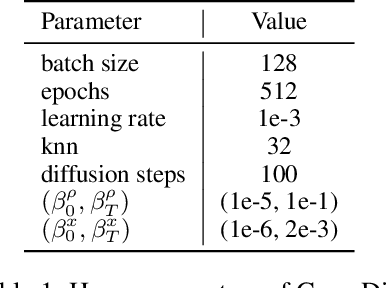
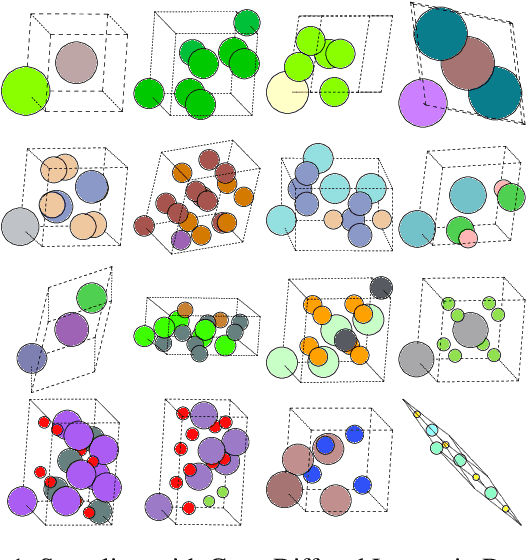

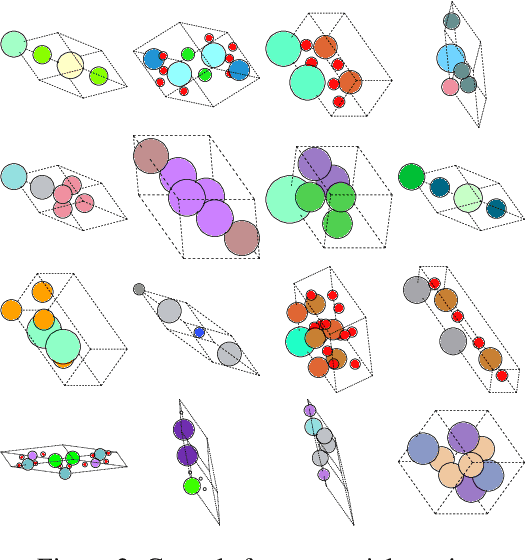
Abstract:Discovering crystal structures with specific chemical properties has become an increasingly important focus in material science. However, current models are limited in their ability to generate new crystal lattices, as they only consider atomic positions or chemical composition. To address this issue, we propose a probabilistic diffusion model that utilizes a geometrically equivariant GNN to consider atomic positions and crystal lattices jointly. To evaluate the effectiveness of our model, we introduce a new generation metric inspired by Frechet Inception Distance, but based on GNN energy prediction rather than InceptionV3 used in computer vision. In addition to commonly used metrics like validity, which assesses the plausibility of a structure, this new metric offers a more comprehensive evaluation of our model's capabilities. Our experiments on existing benchmarks show the significance of our diffusion model. We also show that our method can effectively learn meaningful representations.
What do Deck Chairs and Sun Hats Have in Common? Uncovering Shared Properties in Large Concept Vocabularies
Oct 23, 2023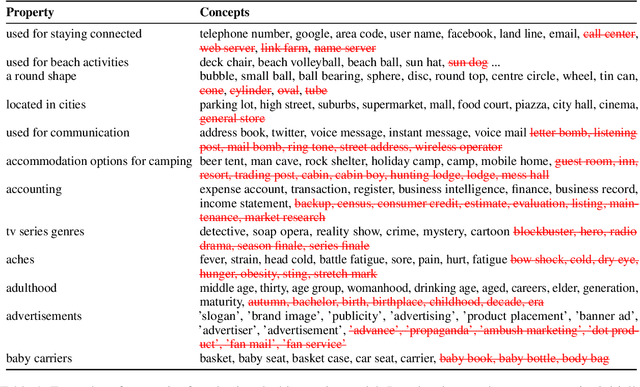
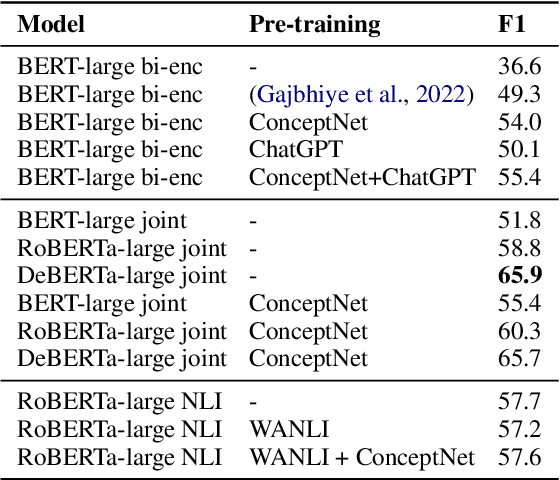
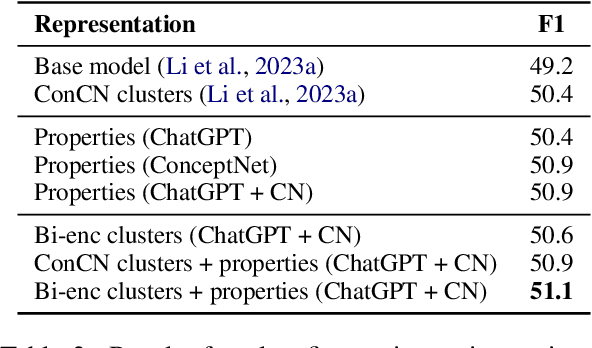

Abstract:Concepts play a central role in many applications. This includes settings where concepts have to be modelled in the absence of sentence context. Previous work has therefore focused on distilling decontextualised concept embeddings from language models. But concepts can be modelled from different perspectives, whereas concept embeddings typically mostly capture taxonomic structure. To address this issue, we propose a strategy for identifying what different concepts, from a potentially large concept vocabulary, have in common with others. We then represent concepts in terms of the properties they share with the other concepts. To demonstrate the practical usefulness of this way of modelling concepts, we consider the task of ultra-fine entity typing, which is a challenging multi-label classification problem. We show that by augmenting the label set with shared properties, we can improve the performance of the state-of-the-art models for this task.
Unified Model for Crystalline Material Generation
Jun 07, 2023Abstract:One of the greatest challenges facing our society is the discovery of new innovative crystal materials with specific properties. Recently, the problem of generating crystal materials has received increasing attention, however, it remains unclear to what extent, or in what way, we can develop generative models that consider both the periodicity and equivalence geometric of crystal structures. To alleviate this issue, we propose two unified models that act at the same time on crystal lattice and atomic positions using periodic equivariant architectures. Our models are capable to learn any arbitrary crystal lattice deformation by lowering the total energy to reach thermodynamic stability. Code and data are available at https://github.com/aklipf/GemsNet.
 Add to Chrome
Add to Chrome Add to Firefox
Add to Firefox Add to Edge
Add to Edge